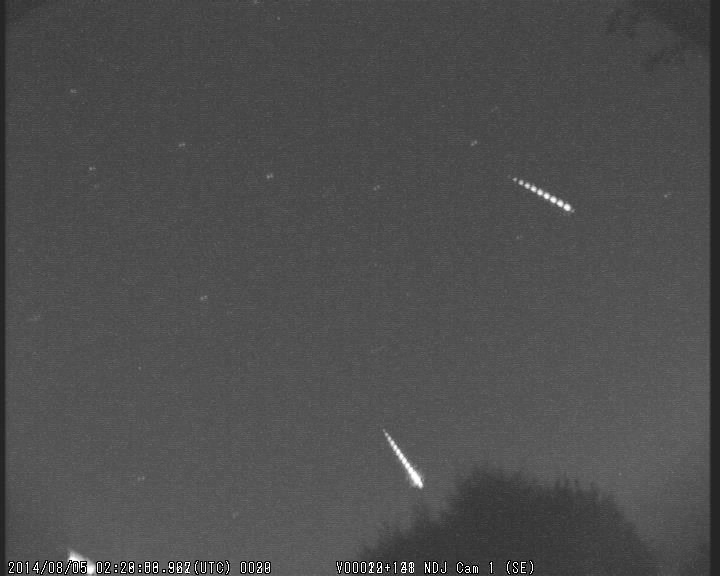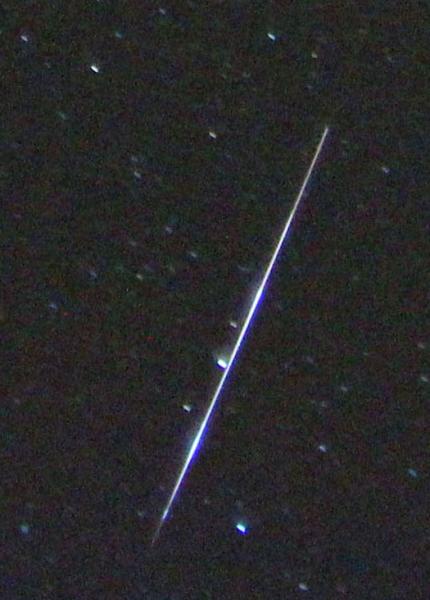2014 August 5
Watch out for the Perseid meteor shower
With many places experiencing clear nights over the past few days, observers across the British Isles have reported increasing Perseid meteor activity. The Perseids are one of the most reliable showers of the annual meteor calendar, producing an abundance of fast, bright meteors and a number of lovely Perseid fireballs have already been reported. The maximum this year is at midnight on the night of August 12/13 which would be ideal for us if it were not for the fact that the Moon will be just after full low to the south in the constellation of Pisces.
Bright m oonlight has an adverse effect on meteor observing, and for a few days to either side of Full Moon, lunar glare swamps many of the fainter meteors, reducing the total number of meteors seen. Fortunately, the Perseid shower contains a high percentage of bright meteors so there should still be a good show if the weather cooperates.
oonlight has an adverse effect on meteor observing, and for a few days to either side of Full Moon, lunar glare swamps many of the fainter meteors, reducing the total number of meteors seen. Fortunately, the Perseid shower contains a high percentage of bright meteors so there should still be a good show if the weather cooperates.
Video meteor systems recorded the first Perseid meteors in mid-July and the shower will continue to be active until late August. The image at left shows two bright Perseids recorded within a few minutes of each other on the morning of August 5. The shower’s activity displays a marked ‘kick’ around August 8-9 and steadily increasing observed rates may be expected from now until the peak. The very best rates will occur in the pre-dawn hours of Wednesday, August 13. As an experiment this year the BAA is streaming live images from meteor TV cameras so that you can keep an eye on the shower.
A number of other, lesser showers are also active at this time of year, such as the Delta and Iota Aquarids and Alpha Capricornids, so there is plenty of interest for the meteor observer. For details of all activity at this time, please refer to the Meteor Diary in the 2014 BAA Handbook.
Observers watching after midnight on August 12-13 should experience increasing activity towards dawn, as the shower radiant at RA 03h 13m, Dec. +58° (near the Double Cluster, on the Perseus-Cassiopeia border) climbs higher in the eastern sky. Visual observers may minimize the effects of moonlight by positioning themselves so the Moon is behind them and hidden behind a wall or other suitable obstruction.
Weather permitting, observers should try to cover Perseid activity on the nights leading up to maximum, particularly on August 10-11 and 11-12 and also after the peak on August 13-14. The Perseids are an ideal target for  digital imaging using DSLRs or high sensitivity TV cameras due to the relative abundance of bright meteors. Observations in recent years have revealed noticeable variations in activity from year to year and we shall just have to wait and see what is in store for us in 2014.
digital imaging using DSLRs or high sensitivity TV cameras due to the relative abundance of bright meteors. Observations in recent years have revealed noticeable variations in activity from year to year and we shall just have to wait and see what is in store for us in 2014.
The BAA’s visual meteor report forms, available as downloads in both pdf and Excel formats, enable observers to record the details of each meteor seen. These include: time of appearance (UT); apparent magnitude (brightness); type (shower member, or random, ‘background’ sporadic); constellation in which seen; presence and duration of any persistent train. Other notes may mention flaring or fragmentation in flight, or marked colour. Watches should ideally be of an hour’s duration or longer (in multiples of 30 minutes). Observers are reminded to carefully record the observing conditions and the stellar limiting magnitude. Further notes on visual observing can be found here.
The image at right is a Perseid recorded in August 2013 using a DSLR camera Such cameras are ideal for recording meteors since multiple time exposures can be taken. The camera was set to ISO1600 and the exposure was 30 seconds using a 16mm, f/2.8 lens.
By whatever means you observe the Perseids this year, please submit your results to the BAA Meteor Section via meteor@britastro.org.
| The British Astronomical Association supports amateur astronomers around the UK and the rest of the world. Find out more about the BAA or join us. |
